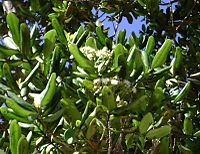| Pimenta racemosa | |
|---|---|

| |

| |
| Conservation status | |
 Least Concern (IUCN 3.1) | |
| Scientific classification | |
| Kingdom: | Plantae |
| Clade: | Tracheophytes |
| Clade: | Angiosperms |
| Clade: | Eudicots |
| Clade: | Rosids |
| Order: | Myrtales |
| Family: | Myrtaceae |
| Genus: | Pimenta |
| Species: | P. racemosa |
| Binomial name | |
| Pimenta racemosa (Mill.) J.W.Moore | |
| Synonyms | |
List
| |
Pimenta racemosa is a species of plant in the myrtle family (Myrtaceae) that is native to the Caribbean region. Common names include West Indian bay tree, bay rum tree, and ciliment.
Uses
It is used in cooking and an essential oil is distilled to produce a fragrant cologne called bay rum; although the name is similar to names of flavored alcoholic beverages, the concentrated essential oil from the fruit is toxic and renders the product undrinkable. The leaves are also used for herbal teas.
Anti-inflammatory and antinociceptive properties
Extracts from multiple varieties of Pimenta racemosa display anti-inflammatory properties. These properties are mediated in part by terpenes such as abietic acid and lupeol, which alter neutrophil migration into inflamed regions.
Pimenta racemosa also demonstrates antinociceptive properties and has historically been used as an analgesic in the Caribbean.
Description
The tree is 4–12 m tall and the white flowers, about 10 mm wide, become black, oval fruits measuring 7–12 mm. The ideal conditions for P. racemosa are regular irrigation and bright sunshine.
 Seeds
Seeds Leaves
Leaves
Ecology
Pimenta racemosa is widely introduced and can become an invasive weed. The plants are now grown widely in other tropical areas, including Oceania.
References
- IUCN SSC Global Tree Specialist Group; Botanic Gardens Conservation International (BGCI) (2022). "Pimenta racemosa". IUCN Red List of Threatened Species. 2022: e.T62783A208346431. doi:10.2305/IUCN.UK.2022-1.RLTS.T62783A208346431.en. Retrieved 7 January 2023.
- "The Plant List: A Working List of all Plant Species".
- ^ "Pimenta racemosa". Germplasm Resources Information Network. Agricultural Research Service, United States Department of Agriculture. Retrieved 2012-08-23.
- desert-tropicals.com: West Indian Bay Tree, Bay Rum Tree
- Fernández, MA; Tornos, MP; García, MD; de las Heras, B; Villar, AM; Sáenz, MT (18 February 2010). "Anti-inflammatory activity of abietic acid, a diterpene isolated from Pimenta racemosa var. grissea". Journal of Pharmacy and Pharmacology. 53 (6): 867–872. doi:10.1211/0022357011776027.
- Fernández, A; Álvarez, A; Garcı́a, MD; Sáenz, MT (April 2001). "Anti-inflammatory effect of Pimenta racemosa var. ozua and isolation of the triterpene lupeol". Il Farmaco. 56 (4): 335–338. doi:10.1016/S0014-827X(01)01080-1.
- Garcı́a, MD; Fernández, MA; Alvarez, A; Saenz, MT (March 2004). "Antinociceptive and anti-inflammatory effect of the aqueous extract from leaves of Pimenta racemosa var. ozua (Mirtaceae)". Journal of Ethnopharmacology. 91 (1): 69–73. doi:10.1016/j.jep.2003.11.018.
- ^ Pacific Island Ecosystems at Risk (PIER): Myrtaceae: Pimenta racemosa (by J.W.Moore)
- "USDA PLANTS Profile".
External links
![]() Data related to Pimenta racemosa at Wikispecies
Data related to Pimenta racemosa at Wikispecies
![]() Media related to Pimenta racemosa at Wikimedia Commons
Media related to Pimenta racemosa at Wikimedia Commons
| Taxon identifiers | |
|---|---|
| Pimenta racemosa |
|
| Caryophyllus racemosus | |
This Myrtaceae article is a stub. You can help Misplaced Pages by expanding it. |